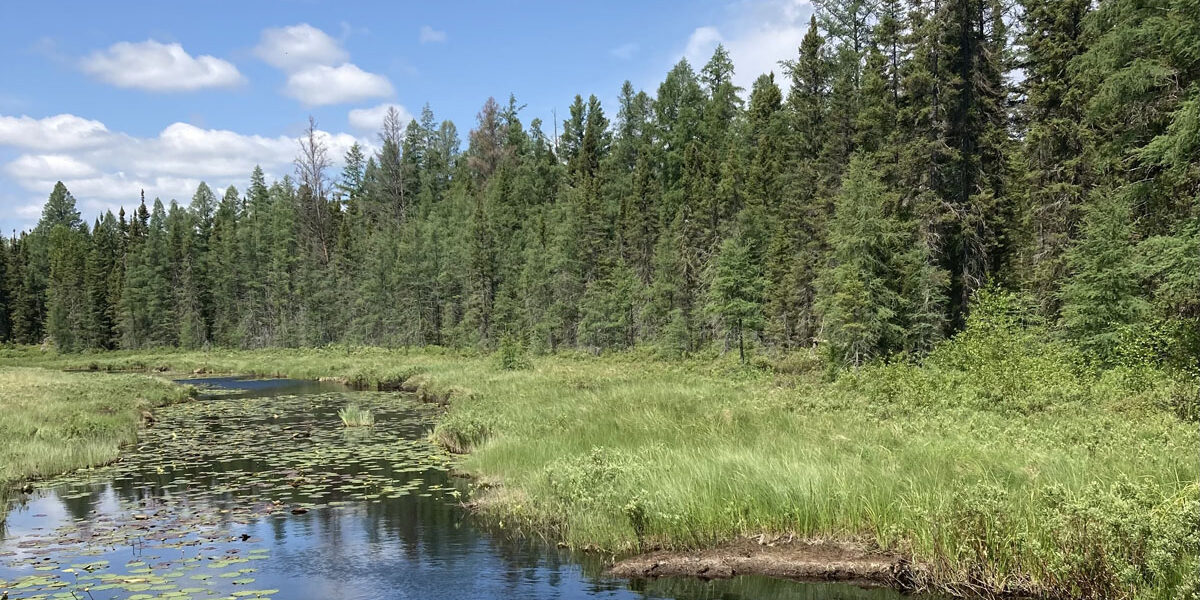Trail Time
Summer is upon us on the Gunflint Trail and once again we feel the energetic speedup of the season. With more daylight and endless opportunities to enjoy nature, the days stretch out and feel longer — sometimes languorous and sometimes jam-packed with both work and play.
We’ve had plenty of rain so the fire danger has lowered. Flowers are blooming and the air is full of their scent. Twice yesterday I stopped in my tracks to find out what was that beautiful fragrance I was detecting. One was a large wild rose plant that I had walked right by. Its bright pink blooms were all wide open and various kinds of bees and insects were in attendance, collecting nectar and spreading pollen. The second time I could not readily find the source of a strong grape kool-aid aroma I was smelling. I roved around nose up, nostrils wide and discovered it was white clover, which, along with red clover, is considered an invasive species. I am guilty of loving several invasive species, and that includes both clover and lupines.
I was so disheartened when I first learned that about lupine’s status years ago. I have always loved how they cover the roadsides! But I had assumed when I moved here that I also inherited a life goal to rid my corner of the world of all invasive plants. But I simply can’t with the lupines and I can’t with the clover. They are too beautiful. As a gardener, I feel the tug of duty. As a human, I just see the loveliness.
The lupines on the Gunflint Trail are having a banner year. Everything is so lush and green with the recent rains. We had an unusual May — the insects have not been bad at all. I would encourage wearing a bug net if you are going into deep woods, though, along with long sleeve lightweight shirts and pants.
Luckily for us, at dusk and at dawn when biting insects are at their most active, the dragonflies are on patrol. And they fill the sky above us when we sit on our deck in the evening and watch them come in for the kill, snapping up mosquitoes and black flies with deadly precision and amazing maneuvers. It’s like getting your own air show. The dragonflies are like heroes swooping in to save the day.
There are thirty-one different dragonfly species in the north woods. That does not include the slender damselflies that we see alighting on lily pads and maybe catching a ride on the gunwale of your canoe. Damselflies are closely related, but belong to a different suborder than dragonflies. They can be identified by the way they hold their wings, which is upright rather than to the sides. Their eyes are separate, rather than touching each other, and their slight build and weak fluttery flight mark them as damselflies.
Dragons and damsels — we’ve entered the language of a fairy tale. Dragonflies have always been surrounded by folklore and suspicion and so have inherited some interesting names from the past: they’ve been called Devil’s Darning Needle, Snake Doctor, Adderbolt, Water Witch and Hobgoblin Fly among others. Their current common names are descriptive and seem to me as fanciful as their old names: there’s the Beaverpond Baskettail, the Rusty Snaketail, the Dragonhunter and the white face Meadowhawk. Only one of them lasts all summer: the Common Green Darner; each species has its own niche in time to live out its life cycle and lay eggs for next year.
We don’t have any dragonflies that overwinter in Minnesota; their larvae take one to three years to develop into the adult stage, spending that developmental time in water. If you have ever seen a kind of creepy-looking gray-green carapace on a rock in or by water, you’ve seen the dragonfly larval form. When the larva are ready for metamorphosis they crawl onto a rock. The back of the carapace splits open and the newly formed dragonfly crawls out. It’s so creepy and wonderful. The dragonfly slowly unfurls and waits for its wings to stiffen so it can begin the next stage of life in the air, scooping up those bugs, patrolling the skies like ace helicopter pilots.
— This is Marcia Roepke on the Gunflint Trail











